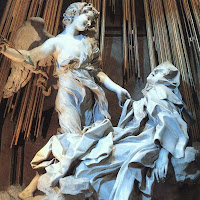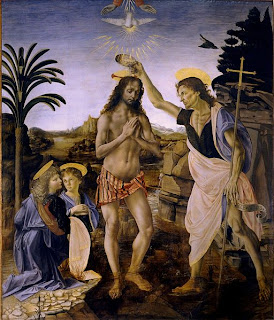 |
| Judith Slaying Holofernes, Artemesia Gentileschi, photo courtesy of Wikipedia CC |
Baroque painters of the 1600s adapted theatrical qualities
on canvas through dramatic chiaruscuro, lighting and action. The father of Baroque painting in Rome,
Caravaggio (1571-1610), often painted a tight, intimate scene in which light played a major
role. Many painters began to
follow the style of Caravaggio, such as Artemesia Gentileschi (1593-1656), a female
contemporary. Gentileschi’s most
famous piece, Judith Slaying Holoferness, from
1614-1620, is her version of a famous piece of the same scene by
Caravaggio. Some say this is her
response to his painting.
Gentileschi’s
Judith is a strong woman, forcing the
sword through Holoferness’ neck as she grasps his hair with her hand. Blood spurts from the wound onto her
chest and arms and runs down crisp white sheets. The scene is dynamic with movement. Gentileschi’s Judith is a powerful
woman, which contrasts to the dainty feminine Judith in Caravaggio’s depiction.
 |
| Judith Slaying Holofernes (1598-99), Caravaggio, photo courtesy of Wikipedia CC |
However,
Gentileschi in heavily influenced by Caravaggio’s style: an attention to
physical darkness and lightness to make up the composition. As in Caravaggio’s paintings,
Gentileschi’s scene is lit by a stark light, which comes from out of the canvas
and gleams on only the three figures in the foreground. The background is completely shaded in
darkness. The heightened drama
creates a tone of concealed danger. Gentileschi's painting reflects a darker side to femininity, just as Caravaggio's paintings reveal his own dark side.
















